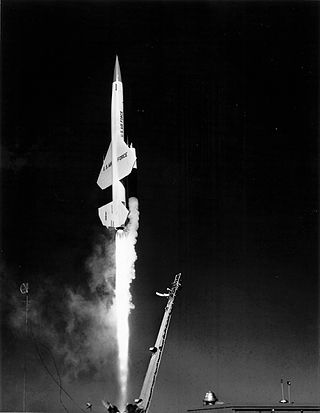
The Boeing CIM-10 BOMARC was a supersonic ramjet powered long-range surface-to-air missile (SAM) used during the Cold War for the air defense of North America. In addition to being the first operational long-range SAM and the first operational pulse doppler aviation radar, it was the only SAM deployed by the United States Air Force.
The SM-65 Atlas was the first operational intercontinental ballistic missile (ICBM) developed by the United States and the first member of the Atlas rocket family. It was built for the U.S. Air Force by the Convair Division of General Dynamics at an assembly plant located in Kearny Mesa, San Diego. Atlas became operational in September 1959, but was soon made obsolete as an ICBM by new development, and was retired from this role by 1965.
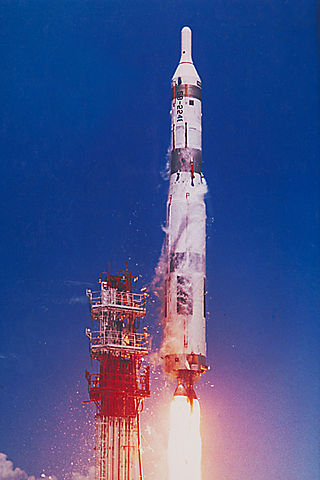
The Martin Marietta SM-68A/HGM-25A Titan I was the United States' first multistage intercontinental ballistic missile (ICBM), in use from 1959 until 1962. Though the SM-68A was operational for only three years, it spawned numerous follow-on models that were a part of the U.S. arsenal and space launch capability. The Titan I was unique among the Titan models in that it used liquid oxygen and RP-1 as propellants; all subsequent versions used storable propellants instead.

Convair, previously Consolidated Vultee, was an American aircraft-manufacturing company that later expanded into rockets and spacecraft. The company was formed in 1943 by the merger of Consolidated Aircraft and Vultee Aircraft. In 1953, it was purchased by General Dynamics, and operated as their Convair Division for most of its corporate history.
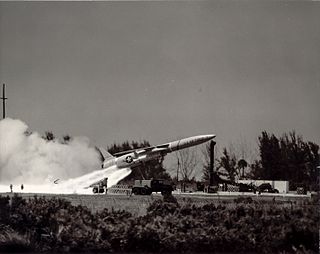
The Northrop SM-62 Snark is an early-model intercontinental range ground-launched cruise missile that could carry a W39 thermonuclear warhead. The Snark was deployed by the United States Air Force's Strategic Air Command from 1958 through 1961. It represented an important step in weapons technology during the Cold War. The Snark was named by Jack Northrop and took its name from the author Lewis Carroll's character the "snark". The Snark was the only surface-to-surface cruise missile with such a long range that was ever deployed by the U.S. Air Force. Following the deployment of ICBMs, the Snark was rendered obsolete, and it was removed from deployment in 1961.

The North American Aviation AGM-28 Hound Dog was a supersonic, turbojet-propelled, nuclear armed, air-launched cruise missile developed in 1959 for the United States Air Force. It was primarily designed to be capable of attacking Soviet ground-based air defense sites prior to a potential air attack by B-52 Stratofortress long range bombers during the Cold War. The Hound Dog was first given the designation B-77, then redesignated GAM-77, and finally AGM-28. It was conceived as a temporary standoff missile for the B-52, to be used until the GAM-87 Skybolt air-launched ballistic missile was available. Instead, the Skybolt was cancelled within a few years and the Hound Dog continued to be deployed for a total of 15 years until its replacement by newer missiles, including the AGM-69 SRAM and then the AGM-86 ALCM.

The North American SM-64 Navaho was a supersonic intercontinental cruise missile project built by North American Aviation (NAA). The final design was capable of delivering a nuclear weapon to the USSR from bases within the US, while cruising at Mach 3 at 60,000 feet (18,000 m) altitude. The missile is named after the Navajo Nation.

The Air Force Missile Development Center and its predecessors were Cold War units that conducted and supported numerous missile tests using facilities at Holloman Air Force Base, where the center was the host unit.

The McDonnell ADM-20 Quail was a subsonic, jet powered, air-launched decoy cruise missile built by McDonnell Aircraft Corporation. The Quail was designed to be launched by the Boeing B-52 Stratofortress strategic bomber and its original United States Air Force designation was GAM-72.

The ADM-160 MALD is a decoy missile developed by the United States.
The Fairchild J83 turbojet was developed starting in 1955 to power cruise missiles used as un-armed decoys for bomber aircraft. The engine's development was terminated in November 1958.
The Convair XSM-74 was a subsonic, jet-powered, ground-launched decoy cruise missile.

The GAM-63 RASCAL was a supersonic air-to-surface missile that was developed by the Bell Aircraft Company. The RASCAL was the United States Air Force's first nuclear armed standoff missile. The RASCAL was initially designated the ASM-A-2, then re-designated the B-63 in 1951 and finally re-designated the GAM-63 in 1955. The name RASCAL was the acronym for RAdar SCAnning Link, the missile's guidance system. The RASCAL project was cancelled in September 1958.
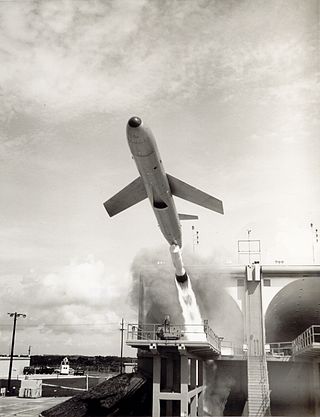
Launch Complex 21 (LC-21) at Cape Canaveral Space Force Station, Florida is a launch complex that was used for horizontal launches of cruise missiles between 1958 and 1963. It initially consisted of a single launch rail, from which XSM-73 Bull Goose missiles were tested. Between 1959 and 1960, the complex was rebuilt for the MGM-13 Mace, with a second rail added, and a large concrete structure erected around the launch rails, earning the pad the nickname of "the hardsite".
Launch Complex 22 (LC-22) at Cape Canaveral Space Force Station, Florida, United States, is a launch complex that was used for horizontal launches of cruise missiles between 1957 and 1960. It consisted of two launch rails, from which XSM-73 Bull Goose and MGM-13 Mace missiles were tested. Unlike the other Mace launch site, Launch Complex 21, no concrete structure was built to enclose the launch rails when it was converted to launch the Mace in 1959. This earned the pad the nickname of "the softsite".

The AAM-A-1 Firebird was an early American air-to-air missile, developed by the Ryan Aeronautical Company. The first air-to-air missile program developed for the United States Air Force, the Firebird was extensively tested in the late 1940s; although it proved successful in testing, it was soon obsolete due to the rapid advances in aircraft and missile technology at the time and did not enter production.

The 6555th Aerospace Test Group is an inactive United States Air Force unit. It was last assigned to the Eastern Space and Missile Center and stationed at Patrick Air Force Base, Florida. It was inactivated on 1 October 1990.
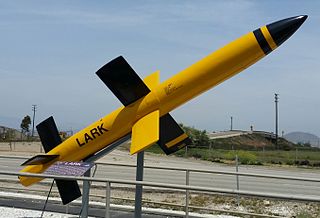
The Lark project was a solid-fuel boosted, liquid-fueled surface-to-air missile developed by the United States Navy to meet the kamikaze threat. It was developed as a crash program to introduce a medium-range defensive layer that would attack targets between the long-range combat air patrols and short-range anti-aircraft artillery. This produced a design with roughly 30 miles (48 km) maximum range and subsonic performance, suitable for attacks against Japanese aircraft.
The Republic SD-4 Swallow was an early high-speed reconnaissance drone developed by Republic Aviation for the United States Army. Intended for use by the U.S. Army Signal Corps to target tactical ballistic missiles, it was cancelled before the first prototype could be completed, and did not see operational service.

The Fairchild SD-5 Osprey was an early high-speed reconnaissance drone developed by Fairchild Aircraft for the United States Army. Intended for use by the U.S. Army Signal Corps to target tactical ballistic missiles, it was cancelled before the first prototype could be completed, and did not see operational service.

















